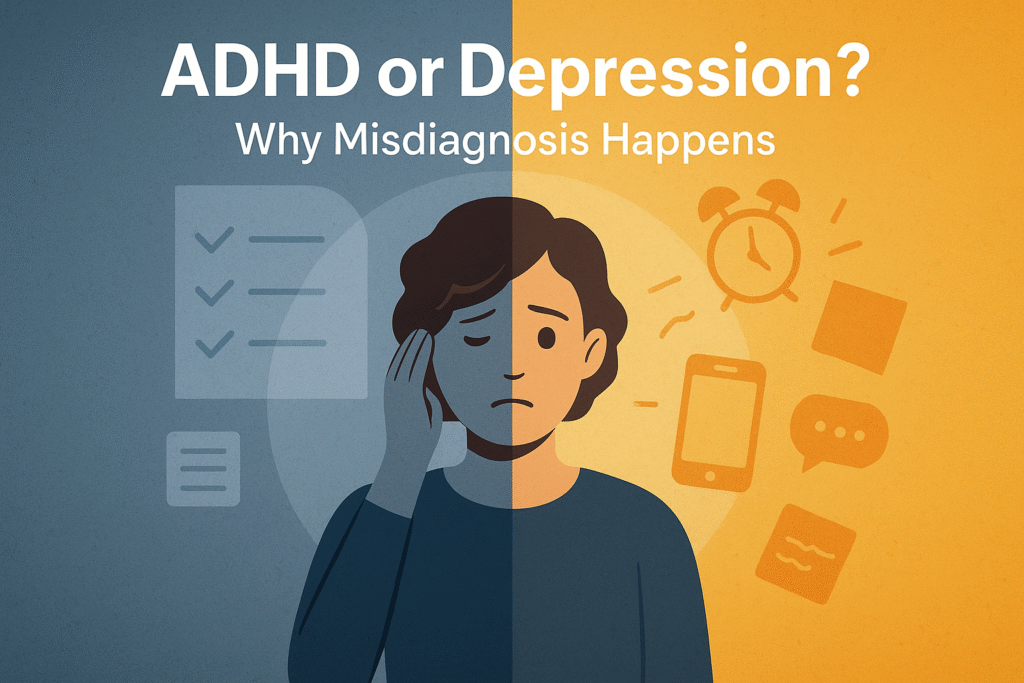
⚠️ Affiliate Disclaimer: This post may contain affiliate links, which means I may earn a small commission — at no extra cost to you — if you make a purchase through one of these links. I only recommend products or services I genuinely trust and believe can provide value. Thank you for supporting My Medical Muse!
Why ADHD Is Often Misdiagnosed as Depression: 7 Key Differences You Must Know”
Why ADHD Is Often Misdiagnosed as Depression
Attention-Deficit/Hyperactivity Disorder (ADHD) and depression are two of the most commonly diagnosed mental health conditions worldwide. Despite their prevalence, both are widely misunderstood not just among the general public but also within medical and psychological fields. One of the most pressing challenges in modern mental health care is that ADHD, particularly in adults, is frequently misdiagnosed as depression.
This misdiagnosis is not a minor error, it carries significant consequences. Adults living with undiagnosed ADHD often endure years of frustration, self-blame, and ineffective treatments. Meanwhile, the true underlying issue executive dysfunction linked to ADHD remains unaddressed. The overlap between symptoms, limited awareness of how ADHD presents in adulthood, and persistent societal stigma all contribute to this diagnostic confusion.
For many individuals, being misdiagnosed means they spend years on antidepressants or in therapies that only partially address their struggles. This prolongs suffering, delays the discovery of effective strategies, and impacts their academic, professional, and personal lives. In some cases, it even leads to a secondary depression that develops as a result of repeated failure, low self-esteem, and constant feelings of inadequacy.
In this article, we’ll explore why ADHD is so often mistaken for depression, highlight the critical differences between the two, and explain why an accurate diagnosis is essential. We’ll also provide insights into what individuals can do if they suspect their symptoms have been misunderstood.
The Overlap Between ADHD and Depression
Shared Symptoms
At first glance, ADHD and depression can look strikingly similar, both conditions involve symptoms that affect daily functioning and overall quality of life. These include:
- Low motivation: Struggling to begin or complete tasks.
- Difficulty concentrating: Trouble focusing on work, conversations, or learning.
- Poor time management: Frequently running late, procrastinating, or missing deadlines.
- Sleep disturbances: Insomnia, restless sleep, or difficulty waking up.
- Low self-esteem: Persistent feelings of inadequacy or failure.
- Frustration or hopelessness: A sense of being stuck, overwhelmed, or unable to meet expectations.
Consider an adult with ADHD, they may struggle to focus at work, miss important meetings, or forget deadlines despite genuine effort. Over time, these repeated difficulties erode confidence, leaving them feeling discouraged and hopeless symptoms that strongly resemble depression.
Likewise, a person experiencing depression may find themselves unable to concentrate, lacking the energy to complete tasks, or withdrawing from responsibilities. From the outside, both scenarios may look identical, making it challenging for even experienced clinicians to distinguish between the two without a deeper assessment.
Symptom Presentation in Adults
Another key factor behind misdiagnosis lies in how ADHD manifests differently across the lifespan. In children, ADHD is often associated with obvious signs of hyperactivity: constant fidgeting, running around, interrupting, or difficulty staying seated. These behaviors make the condition visible and easier to identify.
But in adults, ADHD symptoms shift. Hyperactivity may soften into restlessness, an inner sense of being “always on the go” or mentally scattered. More common adult presentations include:
- Chronic forgetfulness (losing items, missing appointments).
- Persistent disorganization (cluttered environments, messy schedules).
- Emotional dysregulation (overreacting to small frustrations, mood swings).
- Difficulty sustaining focus on boring or routine tasks, despite excelling when highly interested.
Because these symptoms don’t match the stereotype of the “hyperactive child,” they are often overlooked. Instead, when an adult presents as exhausted, unmotivated, or withdrawn, their struggles are frequently misinterpreted as depression. A doctor might ask about fatigue, concentration problems, and low mood and without further probing into lifelong patterns, conclude that depression is the most likely diagnosis.
This overlap creates a diagnostic blind spot, what looks like depression may, in fact, be ADHD wearing a disguise.
Why ADHD Gets Misdiagnosed as Depression
Despite advances in mental health research, ADHD remains one of the most misunderstood conditions, particularly in adults. When symptoms overlap with depression, clinicians often lean toward the more familiar and widely accepted diagnosis. Several factors explain why ADHD so frequently hides behind a depression label.
1. Lack of Awareness About Adult ADHD
For decades, ADHD was framed as a childhood disorder. Textbooks and medical training materials emphasized hyperactive boys who disrupted classrooms, leaving little room for recognizing ADHD beyond adolescence. Many clinicians today were trained under this model, learning to spot ADHD in children but not in adults.
As a result, when an adult reports fatigue, forgetfulness, or low productivity, clinicians are more likely to suspect depression, anxiety, or even personality disorders than ADHD, because ADHD symptoms in adulthood are subtler more about executive dysfunction than obvious hyperactivity, they often escape detection.
This lack of awareness means countless adults live for years without the right diagnosis, trying one treatment after another without meaningful relief.
2. Stigma and Stereotypes
Society still clings to stereotypes about ADHD. It is often trivialized as:
- “Kids being naughty.
- Boys bouncing off walls.
- People making excuses for laziness.
These misconceptions create a diagnostic blind spot. Adults who don’t match the stereotype especially those who are quiet, introspective, or high-achieving may be dismissed altogether.
Meanwhile, depression is more widely acknowledged and socially validated as an adult condition. A person who reports fatigue, low motivation, or difficulty concentrating fits neatly into the cultural image of depression. Clinicians, influenced by these biases, may default to a depression diagnosis rather than considering ADHD.
3. Emotional Fallout From ADHD
Living with untreated ADHD is not just inconvenient, it can be emotionally devastating. Adults with ADHD often face:
- Missed deadlines at work or school.
- Forgotten commitments that strain relationships.
- Chaotic routines that fuel constant stress.
These ongoing challenges can create a cycle of self-blame, shame, and disappointment. Over time, that emotional burden may evolve into secondary depression.
When such individuals seek professional help, clinicians may only see the surface-level sadness and hopelessness, diagnosing depression while overlooking the ADHD that triggered it in the first place. This is particularly harmful because treating the depression without addressing ADHD leaves the root problem unresolved.
4. Diagnostic Checklists Can Be Misleading
Most diagnostic tools for depression ask about:
- Sleep patterns.
- Energy levels.
- Ability to concentrate.
- Motivation and interest in activities.
These are also hallmark ADHD struggles. An adult with ADHD may check every box on a depression screening not because they are clinically depressed, but because their executive dysfunction disrupts sleep, focus, and motivation, without a clinician trained to distinguish between lack of motivation from depression and difficulty initiating tasks due to ADHD, the results can be misleading. The checklist points to depression, while the true culprit is overlooked.
5. Gender Bias in Diagnosis
Women with ADHD are especially vulnerable to misdiagnosis. Unlike many boys, who may display disruptive hyperactivity in childhood, girls are more likely to present with inattentive symptoms such as daydreaming, disorganization, or quiet forgetfulness.
Because these traits don’t demand attention in classrooms, many girls slip through the cracks. As they grow into adulthood, their struggles often look like anxiety or depression:
- Internalized self-criticism.
- Withdrawal or avoidance.
- Chronic overwhelm masked by perfectionism.
Clinicians may see the emotional distress but misinterpret it, labeling it as depression or anxiety instead of ADHD. This gender bias means many women are diagnosed years, sometimes decades later than their male counterparts.
Key Differences Between ADHD and Depression
Although ADHD and depression share overlapping symptoms, they arise from very different root causes. ADHD is a neurodevelopmental condition characterized by executive dysfunction, while depression is a mood disorder driven by persistent low affect and changes in brain chemistry. Understanding these distinctions is essential not only for accurate diagnosis but also for developing the right treatment plan.
1. Motivation
- ADHD: Individuals often feel internally motivated but struggle to translate that drive into consistent action. This difficulty stems from executive dysfunction, the brain’s challenge with initiating, organizing, and sustaining effort. For example, someone with ADHD may be genuinely excited about starting a new project yet unable to move past procrastination, distractions, or disorganization. Their motivation exists, but the “bridge” to action is broken.
- Depression: In contrast, motivation itself is diminished. People with depression often report anhedonia, a lack of pleasure or interest in activities that once brought joy. Even when opportunities are present, they may feel indifferent, detached, or unable to care. Unlike ADHD, the barrier is not task initiation but a deeper emotional disengagement.
2. Onset and Consistency of Symptoms
- ADHD: Symptoms almost always begin in childhood, even if they go unnoticed or unrecognized until adulthood. They are relatively stable across time, showing up in school, work, and home life. For instance, someone who struggled with organization as a child is likely to continue experiencing similar issues as an adult.
- Depression: Symptoms can begin at any age and often occur in episodes. A person may go months or even years feeling well, only to experience a period of low mood, fatigue, and hopelessness triggered by stress, trauma, or biological factors. This cyclical nature distinguishes depression from the lifelong persistence of ADHD
3. Energy Levels
- ADHD: Energy levels fluctuate. Many individuals experience restless bursts of energy or periods of hyperfocus, where they can work on something for hours without pause, followed by sudden crashes of exhaustion. This rollercoaster of productivity and burnout is a hallmark of ADHD.
- Depression: Energy tends to remain consistently low. Fatigue is pervasive and is often described as a heavy, dragging sensation that persists regardless of rest or activity. Unlike ADHD, there are rarely bursts of vitality or hyperfocus.
4. Emotional Experience
- ADHD: Emotions are often intense but fleeting. A person may become frustrated or angry quickly but also recover just as fast. Emotional regulation is a challenge, leading to frequent mood swings but these emotions are situational rather than prolonged.
- Depression: Emotions are persistently low, flat, or empty, often lasting for weeks or months. People with depression frequently describe feeling “numb,” “detached,” or weighed down by sadness, with little relief even when circumstances improve.
5. Response to Environment
- ADHD: Symptoms improve when the environment is stimulating or engaging. For example, someone may struggle endlessly with paperwork yet lose themselves for hours in a hobby, video game, or creative pursuit. This inconsistency is frustrating but is also a key diagnostic clue.
- Depression: Even enjoyable or stimulating activities feel muted or joyless. The inability to experience pleasure, regardless of how engaging the environment is, points more strongly toward depression.
ADHD is about inconsistent ability (sometimes high, sometimes low, depending on context), while depression is about consistently diminished ability and interest.
Consequences of Misdiagnosis
When ADHD is mistaken for depression, the consequences ripple through every aspect of a person’s life. Misdiagnosis doesn’t just delay treatment, it can create new problems that compound the original struggles.
1. Ineffective Treatment
Most commonly, individuals misdiagnosed with depression are prescribed antidepressants. While these medications may alleviate some mood-related issues, they rarely address ADHD’s core challenges: executive dysfunction, impulsivity, and disorganization.
For example, someone who forgets bills, struggles with deadlines, or constantly loses important items will see little improvement from antidepressants alone, without ADHD-specific interventions like stimulant or non-stimulant medications, behavioral strategies, or coaching, the person continues to face the same daily hurdles.
2. Prolonged Suffering
Years of ineffective treatment leave many individuals feeling frustrated and hopeless. They may start to believe their struggles are a personal failing, not a medical one. Imagine repeatedly seeking help, only to be told you’re depressed then feeling no better despite faithfully following treatment. This cycle erodes confidence and deepens shame.
3. Increased Risk of Co-morbidity
When ADHD remains untreated, the constant stress of living with unmanaged symptoms can lead to true depression or anxiety. After years of academic failures, workplace struggles, and strained relationships, many adults with ADHD develop secondary mental health conditions. This makes treatment even more complex, as clinicians must then address both the original ADHD and the resulting depression or anxiety.
4. Strain on Relationships and Careers
The effects of misdiagnosis extend beyond the individual. ADHD symptoms, missed appointments, forgetfulness, impulsive decisions, or emotional outbursts can strain personal relationships. Partners, family, and friends may interpret these behaviors as carelessness or lack of concern, creating conflict and resentment.
In the workplace, untreated ADHD often leads to underperformance, missed opportunities, or even job loss. Over time, these setbacks reinforce feelings of inadequacy, feeding the very cycle of sadness and self-doubt that initially led to a misdiagnosis of depression.
The Importance of Correct Diagnosis
Getting the diagnosis right isn’t just about attaching the correct label, it has the power to transform the entire trajectory of someone’s life. Accurate identification determines which treatments will be effective, how a person understands their struggles, and what kinds of support they can access.
Treatment Differences
- ADHD: Effective treatment usually involves a combination of stimulant or non-stimulant medications, behavioral strategies, ADHD coaching, and environmental modifications (such as structured routines, reminders, or tools that reduce distractions). The goal is to strengthen executive function skills and provide practical systems to manage daily life.
- Depression: Treatment typically includes antidepressant medications, psychotherapy (such as cognitive-behavioral therapy), lifestyle changes (like sleep hygiene, exercise, and nutrition), and sometimes more intensive medical interventions. The focus is on lifting mood, restoring energy, and reducing emotional distress.
Without the correct diagnosis, people often receive treatments that only partially address their symptoms. For example, an individual with ADHD who is prescribed antidepressants may notice some improvement in mood but will still struggle with procrastination, disorganization, and impulsivity. Conversely, someone with depression misdiagnosed as ADHD may be given stimulants that worsen anxiety without improving the core issue.
Improved Self-Understanding
An accurate ADHD diagnosis can be life-changing. For many, it reframes years of struggle from being seen as “lazy,” “careless,” or “unmotivated” to recognizing the reality of a neurological condition. This shift reduces shame, increases self-compassion, and allows individuals to approach their lives with more clarity and kindness toward themselves.
For example, realizing that chronic forgetfulness is a symptom not a moral failing can help someone move from self-blame to solution-seeking. That reframing alone often improves confidence and emotional well-being.
Targeted Support
With the right diagnosis, people can finally access tailored strategies that work for them. ADHD-specific interventions include:
- Coaching to improve time management.
- Habit-building systems that support consistency.
- Cognitive-behavioral therapy adapted to ADHD.
- Tools like planners, apps, or accountability partners.
These targeted supports don’t just make life easier, they drastically improve overall functioning, relationships, and long-term mental health.
Steps to Avoid Misdiagnosis
Avoiding misdiagnosis requires awareness, persistence, and collaboration between patients and clinicians. Here are key steps:
- Seek a Specialist
General practitioners may not always have the training to differentiate between ADHD and depression. Psychiatrists, clinical psychologists, or neuropsychologists with expertise in adult ADHD are best equipped to provide accurate assessments. - Review Childhood History
ADHD almost always has roots in childhood, even if it wasn’t recognized at the time. Reviewing school reports, family anecdotes, or early behavioral patterns can help clarify whether symptoms align more with lifelong ADHD or with later-onset depression. - Track Symptom Patterns
Keeping a journal of when symptoms occur, how long they last, and what triggers them can provide valuable insight. ADHD tends to be lifelong and context-dependent, while depression often comes in episodes and affects interest across all areas of life. - Consider Comorbidity
It’s possible and common to have both ADHD and depression. A thorough evaluation should explore the presence of multiple conditions rather than assuming one explains everything. - Advocate for Yourself
If you feel misdiagnosed, don’t be afraid to seek a second opinion. Mental health care should be collaborative, not dismissive. Trusting your instincts and voicing concerns can be the difference between years of misdirected treatment and finally receiving the help you need.
Moving Forward: Awareness and Advocacy
Improving outcomes requires not only individual self-advocacy but also broader cultural and clinical changes.
Reducing Stigma
One of the biggest barriers to accurate diagnosis is the lingering stigma around ADHD. Many still believe it’s just “kids misbehaving” or that adults who struggle are simply disorganized. In reality, adults can and do live with ADHD even if they were never diagnosed as children. Normalizing this conversation reduces shame and ensures more people get evaluated rather than dismissed.
Education for Clinicians
Mental health professionals need ongoing training to recognize ADHD in adults. Updated diagnostic tools, clearer guidelines, and awareness campaigns can help ensure ADHD is considered whenever overlapping symptoms are present. When clinicians view ADHD as a lifelong condition rather than a childhood phase, fewer cases will be misclassified as depression.
Empowering Individuals
Ultimately, individuals living with ADHD or those who suspect they may have it should feel empowered to seek clarity. Online communities, advocacy groups, and educational resources provide support and reduce the isolation that comes with years of misunderstanding. Empowerment means knowing that struggling isn’t a personal flaw, it’s a sign that something deeper may be at play.
Conclusion
ADHD and depression share many overlapping symptoms, which makes misdiagnosis common. Yet the two conditions differ significantly in their root causes, symptom patterns, and treatment approaches. Misdiagnosing ADHD as depression not only delays effective care but also prolongs suffering and increases the risk of additional mental health challenges.
The key to avoiding this lies in awareness, accurate evaluation, and self-advocacy, with the right diagnosis, individuals can access effective treatments, reframe their struggles, and rebuild their confidence.
ADHD is not laziness. It is not carelessness and it is certainly not a personality flaw, while it may sometimes coexist with depression, it is a distinct condition that deserves recognition and tailored support.
Recognizing this distinction isn’t just a matter of semantics, it’s a matter of giving countless individuals the opportunity to live more balanced, fulfilling, and empowered lives.
👩⚕️ Need Personalized Health Advice?
Get expert guidance tailored to your unique health concerns through MuseCare Consult. Our licensed doctors are here to help you understand your symptoms, medications, and lab results—confidentially and affordably.
👉 Book a MuseCare Consult NowRelated Blog Post You Might Like:
- 7 Proven Ways ADHD Affects Sleep and Productivity (And How to Fix It)
- The Hidden Struggle of Masking in Neurodivergent Adults: 10 Shocking Costs You Need to Know
- 10 Early Signs of Autism in Adults You Shouldn’t Ignore
- 20 Powerful Signs of ADHD in Adults That Most People Miss
- Burnout Symptoms in Men: 7 Powerful Ways to Recover Quickly


